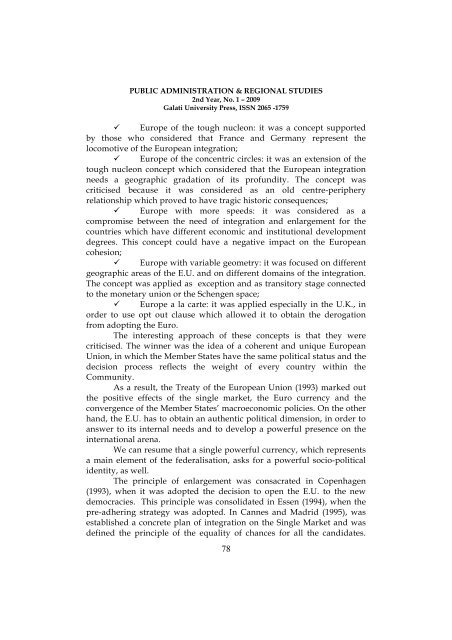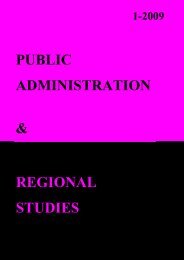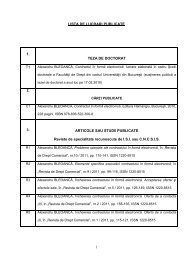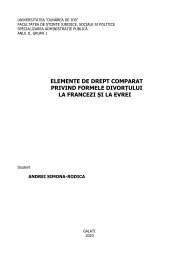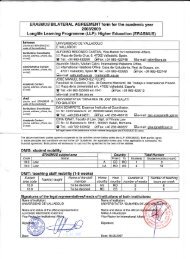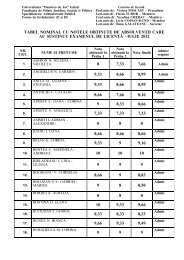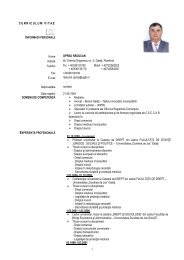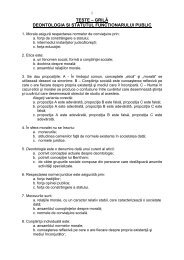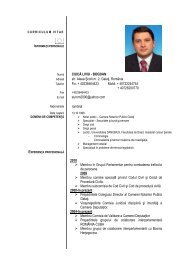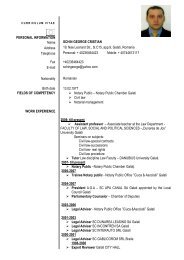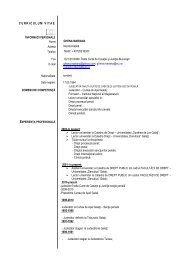regional studies public administration - Facultatea de Drept ...
regional studies public administration - Facultatea de Drept ...
regional studies public administration - Facultatea de Drept ...
Create successful ePaper yourself
Turn your PDF publications into a flip-book with our unique Google optimized e-Paper software.
PUBLIC ADMINISTRATION & REGIONAL STUDIES<br />
2nd Year, No. 1 – 2009<br />
Galati University Press, ISSN 2065 -1759<br />
Europe of the tough nucleon: it was a concept supported<br />
by those who consi<strong>de</strong>red that France and Germany represent the<br />
locomotive of the European integration;<br />
Europe of the concentric circles: it was an extension of the<br />
tough nucleon concept which consi<strong>de</strong>red that the European integration<br />
needs a geographic gradation of its profundity. The concept was<br />
criticised because it was consi<strong>de</strong>red as an old centre-periphery<br />
relationship which proved to have tragic historic consequences;<br />
Europe with more speeds: it was consi<strong>de</strong>red as a<br />
compromise between the need of integration and enlargement for the<br />
countries which have different economic and institutional <strong>de</strong>velopment<br />
<strong>de</strong>grees. This concept could have a negative impact on the European<br />
cohesion;<br />
Europe with variable geometry: it was focused on different<br />
geographic areas of the E.U. and on different domains of the integration.<br />
The concept was applied as exception and as transitory stage connected<br />
to the monetary union or the Schengen space;<br />
Europe a la carte: it was applied especially in the U.K., in<br />
or<strong>de</strong>r to use opt out clause which allowed it to obtain the <strong>de</strong>rogation<br />
from adopting the Euro.<br />
The interesting approach of these concepts is that they were<br />
criticised. The winner was the i<strong>de</strong>a of a coherent and unique European<br />
Union, in which the Member States have the same political status and the<br />
<strong>de</strong>cision process reflects the weight of every country within the<br />
Community.<br />
As a result, the Treaty of the European Union (1993) marked out<br />
the positive effects of the single market, the Euro currency and the<br />
convergence of the Member States’ macroeconomic policies. On the other<br />
hand, the E.U. has to obtain an authentic political dimension, in or<strong>de</strong>r to<br />
answer to its internal needs and to <strong>de</strong>velop a powerful presence on the<br />
international arena.<br />
We can resume that a single powerful currency, which represents<br />
a main element of the fe<strong>de</strong>ralisation, asks for a powerful socio-political<br />
i<strong>de</strong>ntity, as well.<br />
The principle of enlargement was consacrated in Copenhagen<br />
(1993), when it was adopted the <strong>de</strong>cision to open the E.U. to the new<br />
<strong>de</strong>mocracies. This principle was consolidated in Essen (1994), when the<br />
pre-adhering strategy was adopted. In Cannes and Madrid (1995), was<br />
established a concrete plan of integration on the Single Market and was<br />
<strong>de</strong>fined the principle of the equality of chances for all the candidates.<br />
78


